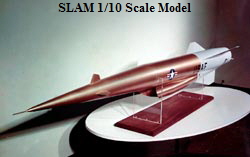|
 Studies of the feasibility of using nuclear power for propulsion officially began in New York City in May 1946 but were moved to Oak Ridge, Tennessee, in September of that year to be at the source of nuclear technology. The NEPA (Nuclear Energy for Propulsion of Aircraft) Project made numerous studies of the direct air cycle in which air is heated by conduction as it passes through a nuclear reactor. The design of ceramic reactors led to the possibility of a nuclear ramjet with unlimited range. In November of 1955 the U.S. Office of Strategic Development asked the Atomic Energy Commission to determine the feasibility of this concept. By October 1956 the world situation was such that the U.S. Air Force issued a System Requirement (SR #149) for a nuclear-powered winged missile. Further internal Air Force studies and reactor development at General Electric’s Aircraft Nuclear Propulsion Project and later at the Lawrence Radiation Laboratory of the University of California indicated overall feasibility of the nuclear reactor. The Cold War situation at the time dictated the need for a strategic missile with positive deterrence or retaliation capability. Chance Vought also recognized the need and in 1957 formed a study group under Dr. Walt Hesse to do unfunded studies. These and studies at other aircraft companies resulted in the United States Air Force issuing Requests for Proposal which were sent out to the aircraft industry. Studies of the feasibility of using nuclear power for propulsion officially began in New York City in May 1946 but were moved to Oak Ridge, Tennessee, in September of that year to be at the source of nuclear technology. The NEPA (Nuclear Energy for Propulsion of Aircraft) Project made numerous studies of the direct air cycle in which air is heated by conduction as it passes through a nuclear reactor. The design of ceramic reactors led to the possibility of a nuclear ramjet with unlimited range. In November of 1955 the U.S. Office of Strategic Development asked the Atomic Energy Commission to determine the feasibility of this concept. By October 1956 the world situation was such that the U.S. Air Force issued a System Requirement (SR #149) for a nuclear-powered winged missile. Further internal Air Force studies and reactor development at General Electric’s Aircraft Nuclear Propulsion Project and later at the Lawrence Radiation Laboratory of the University of California indicated overall feasibility of the nuclear reactor. The Cold War situation at the time dictated the need for a strategic missile with positive deterrence or retaliation capability. Chance Vought also recognized the need and in 1957 formed a study group under Dr. Walt Hesse to do unfunded studies. These and studies at other aircraft companies resulted in the United States Air Force issuing Requests for Proposal which were sent out to the aircraft industry.
In August 1958, Chance Vought Aircraft, North American Aviation, and Convair were selected to conduct funded studies of a low-altitude nuclear-powered strategic missile for a mission no chemical-powered vehicle could perform.
In early 1961 another competition was held among the three aircraft companies for a contract to study and demonstrate the feasibility of the missile airframe and subsystems. This competition was won by Chance Vought Aircraft and a contract was awarded in April 1961, titled “Aerothermo-dynamics for Pluto”. Pluto was the code name of the ceramic reactor development project then being done at Lawrence Radiation Laboratory.
Studies, design and tests of a nuclear- powered strategic missile weapon system were conducted at Chance Vought Aircraft during the period from early 1956 to mid1964. During this period all the technical unknowns were evaluated and shown to be solvable. A conceptual design of a missile was completed and a test nuclear reactor for propulsion was operated at full power.
SLAM Description:
Airframe
Electronics and Guidance
Radiation and Reactor
Muscle in Mothballs
SLAM Flight Profile
|